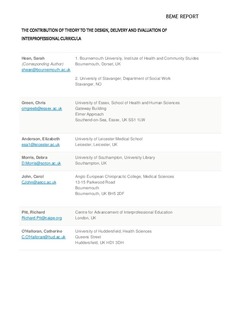| dc.contributor.author | Hean, Sarah | |
| dc.contributor.author | Green, Christopher | |
| dc.contributor.author | Anderson, Elizabeth | |
| dc.contributor.author | Morris, Debra | |
| dc.contributor.author | John, Carol | |
| dc.contributor.author | Pitt, Richard | |
| dc.contributor.author | O'Halloran, Cath | |
| dc.date.accessioned | 2019-08-23T13:30:11Z | |
| dc.date.available | 2019-08-23T13:30:11Z | |
| dc.date.created | 2018-03-19T10:40:10Z | |
| dc.date.issued | 2018-02 | |
| dc.identifier.citation | Hean, S., Green, C., Anderson, E. (2018) The contribution of theory to the design, delivery, and evaluation of interprofessional curricula: BEME Guide No. 49. Medical teacher, 40 (6), pp. 542-558. | nb_NO |
| dc.identifier.issn | 0142-159X | |
| dc.identifier.uri | http://hdl.handle.net/11250/2610001 | |
| dc.description | This is an Accepted Manuscript of an article published by Taylor & Francis in Medical Teacher on 19 Feb 2018, available online: https://www.tandfonline.com/doi/full/10.1080/0142159X.2018.1432851. | nb_NO |
| dc.description.abstract | Background: Interprofessional curricula have often lacked explicit reference to theory despite calls for a more theoretically-informed field that illuminates curricular assumptions and justifies curricular practices.
Aim: To review the contributions of theory to the design, delivery and evaluation of interprofessional curricula
Methods: Four databases were searched (1988-2015). Studies demonstrating explicit and a high quality contribution of theory to the design, delivery or evaluation of interprofessional curricula were included. Data were extracted against a comprehensive framework of curricular activities and a narrative synthesis undertaken.
Results: Ninety-one studies met the inclusion criteria. The majority of studies (86%) originated from the UK, USA and Canada. Theories most commonly underpinned ‘learning activities’ (47%) and ‘evaluation’ (54%). Theories of reflective learning, identity formation, and contact hypothesis dominated the field though there are many examples of innovative theoretical contributions.
Conclusions: Theories contribute considerably to the interprofessional field, though many curricular elements remain under-theorised. The literature offers no ‘gold standard’ theory for interprofessional curricula, rather theoretical selection is contingent upon the curricular component to which theory is to be applied. Theories contributed to interprofessional curricula by explaining, predicting, organising or illuminating social processes embedded in interprofessional curricular assumptions. This review provides guidance how theory might be robustly and appropriately deployed in the design, delivery and evaluation of interprofessional curricula. | nb_NO |
| dc.language.iso | eng | nb_NO |
| dc.publisher | Taylor & Francis | nb_NO |
| dc.subject | høyere utdanning | nb_NO |
| dc.title | The contribution of theory to the design, delivery, and evaluation of interprofessional curricula: BEME Guide No. 49 | nb_NO |
| dc.type | Journal article | nb_NO |
| dc.type | Peer reviewed | nb_NO |
| dc.description.version | acceptedVersion | nb_NO |
| dc.subject.nsi | VDP::Social science: 200::Education: 280 | nb_NO |
| dc.source.pagenumber | 542-558 | nb_NO |
| dc.source.volume | 40 | nb_NO |
| dc.source.journal | Medical teacher | nb_NO |
| dc.source.issue | 6 | nb_NO |
| dc.identifier.doi | 10.1080/0142159X.2018.1432851 | |
| dc.identifier.cristin | 1573854 | |
| cristin.unitcode | 217,7,3,0 | |
| cristin.unitname | Institutt for sosialfag | |
| cristin.ispublished | true | |
| cristin.qualitycode | 1 | |
